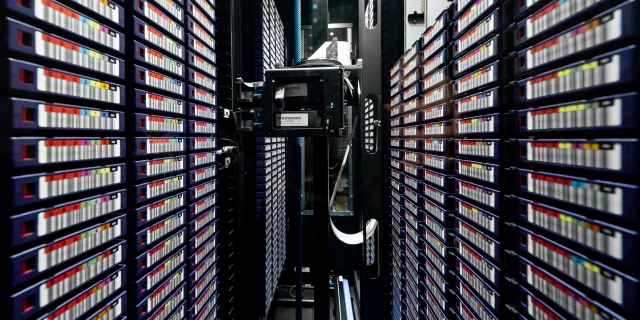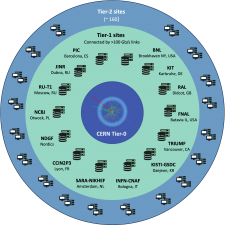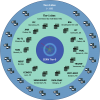CIŚ achieves Tier 1 status for the LHCb experiment at CERN.
2023.12.27 12:16 - Marek PawłowskiThe Świerk Information Center (CIŚ) the National Centre for Nuclear Research (NCBJ) has officially achieved Tier 1 status in the Worldwide LHC Computing Grid (WLCG). This milestone establishes it as a network node for operational data production at the Large Hadron Collider (LHC) in CERN.
See the original text in Polish ->
Read the AI translation:
The CIŚ will be the first data center in Poland to have Tier 1 status for the LHC experiment at CERN. Currently, there are fourteen large Tier 1 centers worldwide that support the main CERN computing center (Tier 0). These centers provide resources for data processing, storage, and round-the-clock network support. They are responsible for storing a proportional share of raw and reconstructed data, both real and simulated, their reprocessing, storage of relevant results, as well as data distribution to local, usually national, Tier 2 centers. The data from LHC experiments are collected and analyzed by thousands of scientists working on the experiments and dispersed around the world.
"Obtaining Tier 1 status for the LHCb experiment is a tremendous success for the Świerk Computing Center and for Polish science," said Professor Wojciech Wiślicki, Director of the Department of Complex Systems Research at NCBJ, the operator of CIŚ. "This recognition is a testament to the work of our scientists and engineers, who have successfully operated a Tier-2 node and coordinated the work of such supercomputers in other centers for many years. With this status, we become part of the global data production infrastructure and significantly raise the rank of Polish research groups working on the LHC. In the near future, we will also obtain Tier 1 status for the CMS experiment."
"It is worth emphasizing that research teams from NCBJ are involved in three major experiments at the LHC: CMS, LHCb, and Alice," adds Professor Krzysztof Kurek, Director of NCBJ. "Our scientists also participate in several smaller CERN experiments and were authors of a proposal for a new experiment called FASER, which was launched this year. NCBJ has designed and produced elements of the CERN experimental infrastructure, including a significant portion of the accelerating structures for the Linac 4 accelerator, an electron accelerator for the G-bar experiment, and subsystems for multi-detectors for the LHCb and CMS experiments."
Additional Information
What is CERN, LHC, and LHCb?
CERN is the European Organization for Nuclear Research, an international scientific organization based in Geneva, Switzerland. LHC is the Large Hadron Collider, the largest and most powerful particle accelerator in the world. LHCb is one of the four main experiments at the LHC, which aims to study the properties of elementary particles, particularly hadrons containing c and b quarks, as well as processes involving these particles that allow for the study of the symmetries governing fundamental interactions in nature. In 2024, CERN will celebrate its 70th anniversary. Numerous events are planned worldwide to bring the history and research topics of the facility closer to the public. Polish scientists plan to bring a CERN exhibition that will be presented in several cities in our country.
How much data do the LHC experiments process?
LHCb, one of the four major experiments at the LHC, generates approximately 20 petabytes of data per year, which is equivalent to 20 million terabytes. This is the amount needed to store all the books in the National Library 100 times over. These data are then stored and processed in the system of successive tiers.
How does the Tier system work in the Worldwide LHC Computing Grid?
The WLCG system is a hierarchical tree-like structure. It consists of four tiers:
- Tier 0: The main computing center at CERN, which processes data from the LHC experiments.
- Tier 1: Regional computing centers, located outside CERN, which process data for one or more experiments. They provide a significant portion of the resources for the entire experiments, taking on commitments regarding their size, efficiency, and reliability.
- Tier 2: Smaller, usually national computing centers, which process data for one or more experiments. These centers do not have operational commitments.
- Tier 3: Local computing centers in scientific institutions, which process data for one or more experiments. These centers usually do not share their resources outside their own institution.
The WLCG connects approximately 1.4 million computer cores and 1.5 exabytes of mass storage from over 170 locations in 42 countries. This vast decentralized computing infrastructure provides over 12,000 physicists around the world with nearly real-time access to LHC data and the ability to process it. It handles over 2 million tasks daily, and by the end of 2021, global data transmission speeds exceeded 260 GB/s. These numbers will continue to increase over time with the availability of computing resources and new technologies worldwide.
What is CIŚ?
The Computing Centre (CIŚ) was established thanks to a project funded by the EU, aiming to accelerate scientific research, as well as research for government administration and the development of the energy sector in Poland. Equipped with state-of-the-art tools and techniques such as supercomputers, cluster computing, cloud computing, numerical analysis, and high-performance computing (HPC), CIŚ has immense capabilities. The center is driving research at NCBJ in the most relevant areas today, such as artificial intelligence (AI), cybersecurity, industrial networks, machine learning, and Big Data. With its high computing power, totaling 1.4 PFLOPS, 36,000 cores, and 200 TB of RAM (as of 2023), CIŚ carries out a comprehensive range of analyses, including thermal-fluid, aerodynamic, and parametric analyses, as well as numerical projects related to nuclear reactors, among others. In the near future, an increase in CIŚ computing power to 1.6 PFLOPS and the launch of a new data center are planned.




















